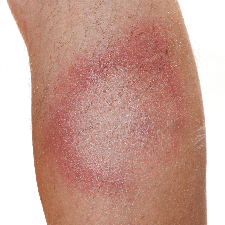Vous pouvez contracter la maladie de Lyme après avoir été mordu(e) par une tique. Il s’agit généralement d’une tique de cerf, infectée par la bactérie Borrelia burgdorferi. Si la tique n’est pas retirée avant 48 à 72 heures, vous risquez de développer cette inffection. Certaines personnes pensent qu’une fois que vous êtes infecté par la maladie de Lyme, vous ne pouvez plus être infecté. Ce qui est faux. C’est pourquoi il est important d’essayer de prévenir la maladie en premier lieu. Dans cet article, nous allons examiner les symptômes de la maladie de Lyme.
Les symptômes fréquents provoqués par la maladie de Lyme
Le premier symptôme de la maladie de Lyme est souvent l’éruption cutanée classique connue sous le nom d’érythèmemigrant. Cependant, il est important de connaître tous les symptômes de la maladie de Lyme car ils peuvent être différents pour chaque individu.
Érythème Migrans

Cette éruption circulaire se produit sur le site de la piqûre de tique, environ sept à 14 jours après avoir été mordue. L’érythème migrant survient chez 70 à 80% des personnes infectées par la maladie de Lyme.
Étant donné que les éruptions cutanées ont un aspect différent selon la personne et le stade de la maladie, il est conseillé d’inviter votre fournisseur de soins de santé à examiner les éruptions cutanées suspectes. Si vous vivez dans une région où les tiques abondent et/ou la maladie de Lyme est fréquente, il est encore plus important de connaître les éruptions cutanées inhabituelles.
Cette éruption cutanée d’érythème migrant peut être décrite comme suit :
- Avoir l’anneau extérieur rouge typique avec un éclaircissement violet foncé entre la zone
- Avoir un anneau extérieur rouge, un centre rouge et une clairière teintée de pourpre entre la zone
- Une éruption cutanée avancée, qui a probablement commencé beaucoup plus petite et qui ressemble moins à un centre-balle.
- Être irritant, chaud et parfois douloureux
- Expansion graduelle jusqu’à une taille de 7 à 14 pouces
Les symptômes pseudo-grippaux dus à la maladie de Lyme
Les autres symptômes de la maladie de Lyme peuvent ressembler à la grippe et peuvent inclure :
- Fièvre
- Myalgie (douleurs musculaires)
- Frissons
- Maux de tête
- Fatigue
- Douleur articulaire (arthralgie)
- Ganglions lymphatiques enflés (adénopathies)
Bien que ces symptômes puissent ressembler à ceux des infections virales courantes, les symptômes de la maladie de Lyme peuvent persister ou se manifester.
Les symptômes rares de la maladie de Lyme
Moins fréquemment, si la maladie de Lyme n’est pas traitée, vous pouvez développer d’autres symptômes des semaines, des mois, voire des années après l’infection, notamment :
- Des éruptions cutanées multiples érythème migrant
- Une inflammation oculaire
- Une hépatite (maladie du foie)
- La fatigue extrême
Aucun de ces problèmes ne risque d’apparaître sans la présence d’autres symptômes de la maladie de Lyme.
Les complications de Lyme
Des symptômes graves et des complications peuvent survenir si votre maladie de Lyme n’est pas traitée. Ceux-ci peuvent se développer des jours à des mois après que vous ayez été piqué par une tique.
Arthrite
Après plusieurs mois d’infection à B. burgdorferi, 30 à 60% des personnes non traitées aux antibiotiques développent des attaques récurrentes d’articulations douloureuses et enflées qui durent de quelques jours à quelques mois. L’arthrite peut passer d’une articulation à une autre et le genou est le plus souvent touché.
Problèmes neurologiques
La maladie de Lyme peut également affecter votre système nerveux, provoquant des symptômes tels que :
- Cou raide et mal de tête sévère (méningite)
- Paralysie temporaire des muscles faciaux dans laquelle un côté du visage s’affaisse (paralysie de Bell)
- Engourdissement, douleur ou faiblesse dans les membres
- Mauvais mouvement musculaire
Des modifications plus subtiles ont également été associées à la maladie de Lyme non traitée, telles que :
- Perte de mémoire
- Difficulté de concentration
- Changement d’humeur ou d’habitudes de sommeil
Des problèmes du système nerveux peuvent se développer des semaines, des mois, voire des années après une infection non traitée. Ces symptômes apparaissent chez environ 10 à 12% des personnes et durent souvent des semaines ou des mois.
Problèmes cardiaques
Environ 1% des personnes atteintes de la maladie de Lyme développent des problèmes cardiaques, tels que des battements de cœur irréguliers. Ces signes peuvent commencer par des vertiges ou un essoufflement et peuvent indiquer une cardite de Lyme, cause du blocage cardiaque. Avec un traitement, ces symptômes durent rarement plus de quelques jours ou quelques semaines.
Quand voir un docteur suite à une morsure de tique?
N’oubliez pas que toutes les personnes ne présentent pas tous les symptômes classiques de la maladie de Lyme. Il est donc important de consulter votre médecin si vous développez une éruption cutanée ou de la fièvre après une morsure de tique. C’est d’autant plus important si vous vivez ou si vous vous êtes rendu dans une région où il y a beaucoup des cas de maladie de Lyme.
Même dans les zones d’hyperendémie (endroits où il y a beaucoup de cas de maladie de Lyme), le risque de développer la maladie de Lyme est généralement estimé à 3,5% au maximum. Il est si bas parce que, même si jusqu’à 50% des tiques des zones d’endémie sont infectées par la bactérie responsable de la maladie de Lyme, la plupart des gens les enlèvent avant que la bactérie n’ait eu le temps de les infecter.
La maladie de Lyme peut être traitée avec des antibiotiques courants. Plus tôt vous serez traité contre la maladie de Lyme, mieux ce sera. Même dans les cas plus avancés, les médicaments répondent généralement bien.
Comment s’assurer de la disparition de la maladie de Lyme ?
De simples tests sanguins, qui doivent parfois être répétés pour éliminer toute infection, peuvent vous donner, à vous et à votre famille, une tranquillité d’esprit.
Sources :
http://www.doctissimo.fr/html/sante/encyclopedie/sa_1238_lyme.htm
https://www.passeportsante.net/fr/Maux/Problemes/Fiche.aspx?doc=maladie_de_lyme_pm



